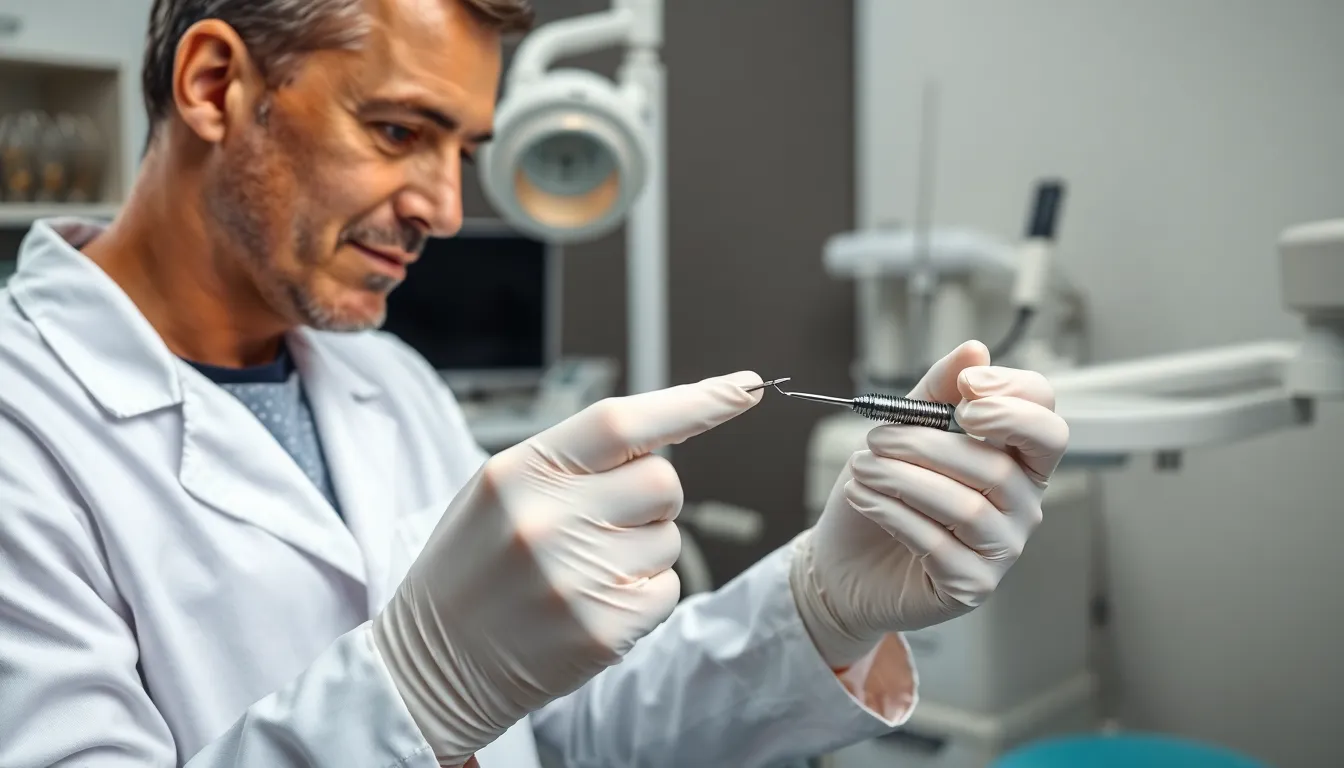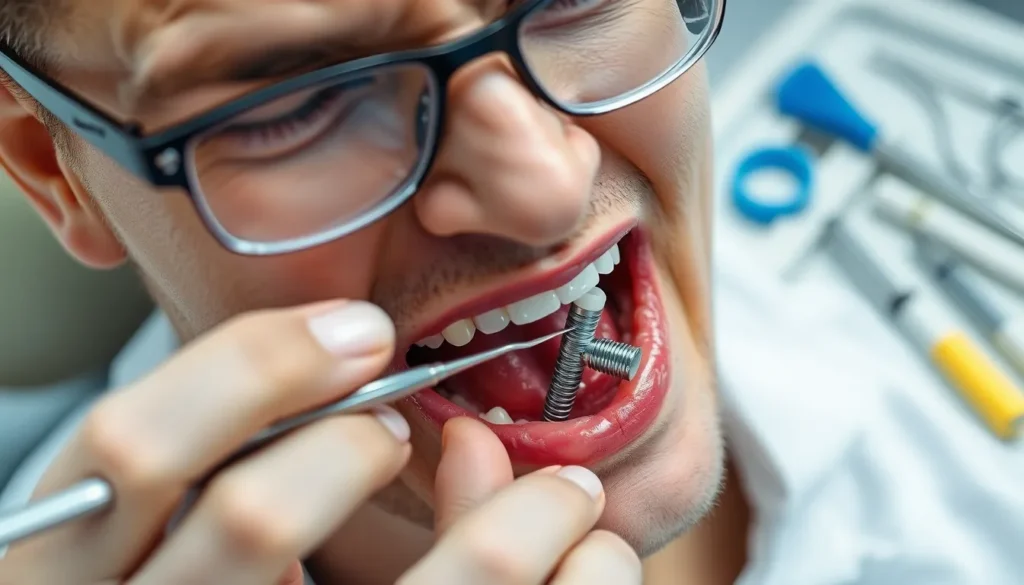Can a loose dental implant be saved? If you’ve noticed your dental implant feeling unstable, you’re likely concerned about what this means for your investment and oral health. This common but serious issue requires prompt attention to prevent further complications.
Dental implant loosening can stem from various causes, including infection, bone loss, or improper healing. The good news is that many loose implants can indeed be saved with timely intervention. Your options depend on what’s causing the looseness and how quickly you seek professional care. Understanding the warning signs and available treatment options could make the difference between saving your implant and needing a complete replacement.
Understanding Dental Implant Mobility
Dental implant mobility refers to any movement detected in an implant that should be firmly anchored in your jawbone. Understanding the difference between normal adaptation and problematic movement helps identify when intervention is necessary.
Normal vs. Problematic Movement
Dental implants undergo a natural settling period after placement that doesn’t indicate failure. During the first few months following surgery, minor physiological changes occur as osseointegration (bone fusion) progresses. These changes aren’t typically perceptible to patients and don’t cause discomfort. A successfully integrated implant feels solid, similar to a natural tooth, with no detectable movement when gentle pressure is applied.
Problematic mobility presents differently. An implant that visibly shifts when you bite down or can be moved with your tongue signals a serious issue. Dr. Harris often recalls a patient who noticed slight movement while flossing around her recently placed implant. “She called our office immediately rather than waiting for her scheduled follow-up,” he notes. “That quick action allowed us to stabilize the implant before important bone loss occurred.”
Common Causes of Loose Dental Implants
Peri-implantitis represents the most frequent cause of implant mobility, affecting approximately 20% of implant patients within five years. This infection resembles gum disease but targets the tissues surrounding implants, causing inflammation, bone deterioration, and eventual loosening. Early detection dramatically improves treatment outcomes.
Inadequate osseointegration occurs when bone fails to properly fuse with the implant surface. Contributing factors include smoking, uncontrolled diabetes, radiation therapy, or insufficient bone volume. Biomechanical overload creates excessive force on implants, typically from teeth grinding, improper bite alignment, or poorly designed prosthetics.
Premature loading happens when implants bear weight before complete healing. Patients who resume normal chewing too quickly risk disrupting the integration process. Technical errors during placement, such as improper angulation or inadequate primary stability, compromise long-term success rates by up to 15%.
Warning Signs of a Failing Dental Implant

Recognizing the warning signs of a failing dental implant allows for early intervention and increases the chances of saving your investment. Dental implants typically function like natural teeth when healthy, but certain symptoms indicate potential problems that require immediate attention.
Early Detection Importance
Early detection of implant problems dramatically improves the likelihood of successful treatment and preservation. Patients who seek prompt care for implant issues often avoid more extensive procedures and complications down the road. The consequences of delayed treatment include accelerated bone loss around the implant, spreading infection to surrounding tissues, and complete implant failure requiring removal and replacement.
One of my patients, Sarah, noticed slight movement in her dental implant when brushing but waited three months before scheduling an appointment. By that time, important bone loss had occurred, making treatment more complex and costly than if she’d come in immediately after noticing the first sign of movement.
Regular dental check-ups play a crucial role in identifying implant issues before they become symptomatic. Dental professionals can detect early signs of trouble through clinical examination and radiographs, often before you experience any discomfort or notice movement.
If you experience pain, swelling, mobility, or gum inflammation around your implant, contact your dentist immediately. These symptoms might indicate infection (peri-implantitis) or mechanical issues with the implant components that require professional evaluation and treatment.
Prompt action when you notice any changes in how your implant feels or functions provides the best opportunity for preserving both the implant and your oral health. Many dental implant complications can be reversed when caught early, but become increasingly difficult to treat as they progress.
Can a Loose Dental Implant Be Saved?

A loose dental implant can often be saved with prompt professional intervention. The success of treatment depends on the underlying cause, extent of damage, and how quickly you seek care after noticing implant mobility.
Treatment Options for Different Stages
Dental professionals employ several approaches to address loose implants based on the exact condition. Periodontal treatment involving deep cleaning and antibiotic therapy effectively combats peri-implantitis and bacterial infections that attack gum tissues surrounding your implant. Bone grafting procedures restore lost bone structure, providing necessary support for unstable implants affected by bone resorption. Dentists can also perform minor repairs or adjustments to the implant components, such as tightening loose screws or replacing damaged parts when the implant itself remains adequately integrated.
Dr. Todd B. Harris recalls, “I recently treated a patient who noticed slight movement in her implant after five years of trouble-free function. Upon examination, we identified early-stage peri-implantitis that hadn’t yet caused important bone loss. Through targeted antibiotic therapy and professional cleaning, we stabilized the implant completely, avoiding the need for surgical intervention.”
In severe cases where the implant has failed to integrate with the bone or extensive damage exists, complete removal might be necessary. Following removal and a healing period, placement of a new implant becomes possible, often after bone grafting to strengthen the site. Alternative tooth replacement options like dental bridges or dentures represent viable answers when implant salvage proves impossible.
Determining Salvageability Factors
Several key factors influence whether your loose implant can be saved. The underlying cause dramatically impacts treatment success rates—infections respond differently to treatment than trauma or failed integration. Severity of bone and tissue loss directly correlates with salvageability; minimal bone resorption offers better prospects for successful intervention compared to extensive deterioration.
Your overall health status and personal habits play crucial roles in implant recovery. Medical conditions like uncontrolled diabetes or habits such as smoking significantly reduce healing capacity and treatment effectiveness. Time remains perhaps the most critical factor in implant salvage. Early intervention dramatically improves success rates, while delays allow conditions to worsen, often leading to irreversible damage.
Patient health assessments help dental professionals determine appropriate treatment paths. Systemic conditions affecting bone metabolism or immune response require consideration when developing treatment plans. Comprehensive evaluation including radiographic assessment provides vital information about bone quality and quantity surrounding the implant, guiding appropriate therapeutic decisions.
The Dental Implant Rescue Process

Saving a loose dental implant requires prompt professional intervention and a strategic approach customized to the underlying cause. Dental professionals employ various techniques to rescue compromised implants, ranging from simple non-invasive procedures to more complex surgical interventions.
Non-Surgical Interventions
Loose dental implants often respond well to conservative treatments that don’t require surgery. Tightening the implant screw offers an immediate solution when looseness stems from connection issues between implant components. Your dentist can perform this simple in-office procedure to secure the implant without invasive treatment. Re-cementing the crown becomes necessary when the adhesive holding your crown to the abutment weakens or breaks, causing instability that’s easily remedied with fresh dental cement.
Splinting techniques provide additional support for structurally sound but loose implants by connecting them to adjacent stable teeth. Temporary stabilization methods like dental cement, denture adhesive, or even toothpaste can offer short-term relief while you await professional care. Treatment of infection plays a crucial role in preserving implant stability, often involving professional cleaning combined with antibiotics to address peri-implantitis before it compromises bone integrity.
Dr. Harris recently treated a patient who noticed her implant crown feeling slightly mobile when brushing. “Instead of waiting until the problem worsened, she called immediately,” he explains. “We discovered a loose abutment screw that we tightened during a 15-minute appointment, completely resolving the issue without any surgical intervention.”
Surgical Repair Techniques
When non-surgical approaches prove insufficient, surgical interventions become necessary to save compromised implants. Bone grafting restores lost structural support around the implant, rebuilding the foundation necessary for stability. This procedure adds bone material to areas where deterioration has occurred, creating a stronger anchor for the existing implant.
Implant replacement represents a last-resort option when an implant has failed to integrate properly or sustained severe damage. Surgical cleaning and debridement remove infected or inflamed tissues around the implant, eliminating peri-implant disease and promoting healing. These procedures typically involve removing diseased tissue, decontaminating the implant surface, and creating conditions favorable for reosseointegration.
One particularly challenging case involved a patient with important bone loss around a front tooth implant. “After careful evaluation, we performed a targeted bone grafting procedure,” shares Dr. Harris. “Six months later, the implant was completely stable with excellent bone regeneration. Taking the surgical route early prevented complete implant failure and avoided the need for a full replacement.”
Dental professionals determine the most appropriate rescue approach based on comprehensive examination, including radiographic assessment of bone levels and evaluation of implant components. Early intervention significantly increases the likelihood of successful implant rescue, preserving both function and aesthetics without starting the implant process from scratch.
Preventing Future Implant Failure

Preserving your dental implant’s longevity requires proactive care and maintenance. Taking exact preventive measures significantly reduces the risk of experiencing implant loosening or failure in the future.
Proper Oral Hygiene Practices
Excellent oral hygiene forms the cornerstone of dental implant maintenance. Brush your teeth at least twice daily using a soft-bristled toothbrush and gentle circular motions around the implant site. Floss carefully around your implant daily to remove food particles and bacteria that can lead to peri-implantitis, a common cause of implant failure. Avoid harsh, alcohol-based mouthwashes that irritate gum tissue and potentially compromise the implant-gum interface. Many patients find that interdental brushes or water flossers provide effective cleaning between implants and natural teeth. One patient, Sarah, maintained her dental implants for over 15 years without complications by following a meticulous oral hygiene routine that included specialized implant-safe cleaning tools recommended by her dentist.
Regular Dental Check-ups
Professional monitoring plays a crucial role in extending implant lifespan. Schedule dental check-ups every 4-6 months to allow for early detection of potential issues before they progress to implant loosening. During these appointments, your dentist examines the implant’s stability, checks for signs of infection or inflammation, and performs professional cleanings to remove hardened plaque that home care might miss. X-rays taken periodically help identify bone loss around implants before it becomes symptomatic. Patients who maintain regular check-ups experience 60% fewer implant complications than those who visit only when problems arise. Your dentist might also recommend specialized maintenance protocols customized to your exact risk factors, such as smoking history or conditions like diabetes that can affect implant health.
When Implant Replacement Is Necessary

Sometimes dental implants reach a point where salvage attempts are no longer viable, and complete replacement becomes the only option. Certain conditions make implant replacement unavoidable even though efforts to save the existing structure.
Severe Bone Loss
Extensive bone loss around an implant compromises its stability beyond repair. When peri-implantitis has progressed significantly, destroying more than 50% of the supporting bone, replacement is typically necessary. Bone grafting may not sufficiently restore the foundation in these advanced cases.
Dr. Todd B. Harris recently noted, “I’ve seen patients delay treatment for loose implants until the bone loss was so extensive that we had no choice but to start fresh. Early intervention could have prevented the need for complete replacement.”
Failed Osseointegration
Implants that never properly fuse with the jawbone require replacement rather than repair. This integration failure can occur during the initial healing phase when the implant doesn’t achieve stability with the surrounding bone. Patients experiencing persistent mobility months after placement likely face an osseointegration issue requiring complete replacement.
Fractured Implant Components
Dental implants with fractured posts or internal components can’t be repaired. Structural damage to the implant body itself creates an irreparable situation that necessitates removal and replacement. These fractures often result from excessive force, manufacturing defects, or material fatigue over time.
Chronic Infection Resistance
Implants surrounded by persistent infections that don’t respond to antibiotics and thorough cleaning need replacement. Therapy-resistant peri-implantitis creates an environment where the implant cannot be maintained safely. Multiple treatment attempts without improvement indicate replacement as the appropriate solution.
Improper Implant Position
Incorrectly positioned implants causing functional problems or aesthetic concerns require replacement. Misalignment issues can lead to complications with bite mechanics and put excessive stress on surrounding structures. A new, properly positioned implant offers better long-term outcomes than attempting to compensate for poor placement.
One patient shared: “My implant was loose and causing pain for months. After trying several treatments to save it, my dentist finally explained that the bone loss was too severe. While starting over with a new implant wasn’t ideal, the replacement procedure went smoothly, and my new implant has been solid for years now.”
The replacement process typically involves removing the failed implant, allowing the site to heal, possibly performing bone grafting, and then placing a new implant. Though this extends the overall treatment timeline, it provides the opportunity for successful long-term outcomes when saving the original implant isn’t possible.
Conclusion
A loose dental implant often can be saved when addressed promptly. Your swift action is key—reaching out to your dentist at the first sign of mobility significantly improves treatment outcomes.
Whether requiring a simple tightening of components or more advanced interventions like bone grafting treatment options exist for many situations. Remember that preventive care plays a crucial role in maintaining implant stability long-term.
While some cases eventually require replacement maintaining regular dental visits and practicing proper oral hygiene helps detect potential issues before they compromise your implant’s integrity. Don’t hesitate to seek professional evaluation if you notice any changes in your dental implant—it could mean the difference between a quick fix and complete replacement.
Frequently Asked Questions
What are the common causes of loose dental implants?
Common causes include peri-implantitis (infection around the implant), inadequate osseointegration (failure of the implant to fuse with bone), biomechanical overload, premature loading of the implant, and technical errors during placement. Identifying the specific cause is crucial for determining the appropriate treatment approach and preventing further complications.
How can I tell if my dental implant is loose?
Warning signs include pain or discomfort around the implant, visible movement of the implant or crown, swelling or inflammation of surrounding gums, bleeding when brushing near the implant, and a metallic taste or bad breath. Any mobility beyond the microscopic level is abnormal and requires immediate professional attention.
Can a loose dental implant be saved?
Yes, many loose implants can be saved with prompt intervention. Treatment options depend on the underlying cause and may include periodontal treatment for infections, bone grafting for structural support, or repairs to implant components. Early detection and treatment significantly increase the chances of saving the implant without replacement.
What is the difference between normal implant settling and problematic mobility?
Normal settling involves microscopic physiological changes during the initial healing period after placement. Problematic mobility is characterized by noticeable shifting or movement of the implant that can be felt or seen. While some minor adaptation is expected, any perceptible movement indicates a potential issue requiring dental evaluation.
What non-surgical treatments are available for loose implants?
Non-surgical interventions include tightening loose abutment screws, re-cementing crowns, temporary stabilization methods, and targeted antibiotic therapy for infections. These conservative approaches can effectively address minor issues without requiring invasive procedures, particularly when the problem is caught early.
When is dental implant replacement necessary?
Replacement becomes necessary with severe bone loss, failed osseointegration, fractured implant components, persistent infection resistant to treatment, or improper implant positioning. Complete replacement involves removing the failed implant, allowing healing, possible bone grafting, and placing a new implant.
How can I prevent my dental implant from becoming loose?
Maintain proper oral hygiene by brushing twice daily with a soft-bristled toothbrush and flossing around the implant. Attend regular dental check-ups every 4-6 months for professional monitoring. Avoid excessive forces on the implant by not chewing hard foods with it and wearing a night guard if you grind your teeth.
How long does the dental implant rescue process take?
The timeline varies depending on the underlying issue. Simple problems like loose abutment screws may be fixed in a single appointment. Cases requiring bone grafting or infection treatment may take several weeks to months. Early intervention typically results in shorter treatment times and better outcomes.







